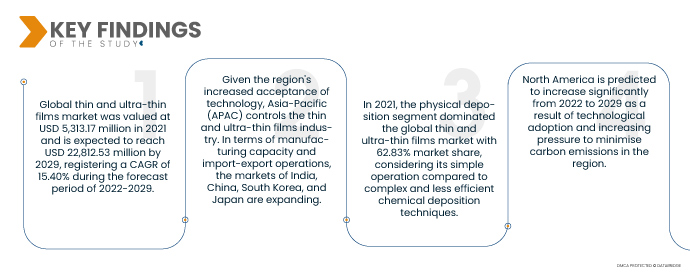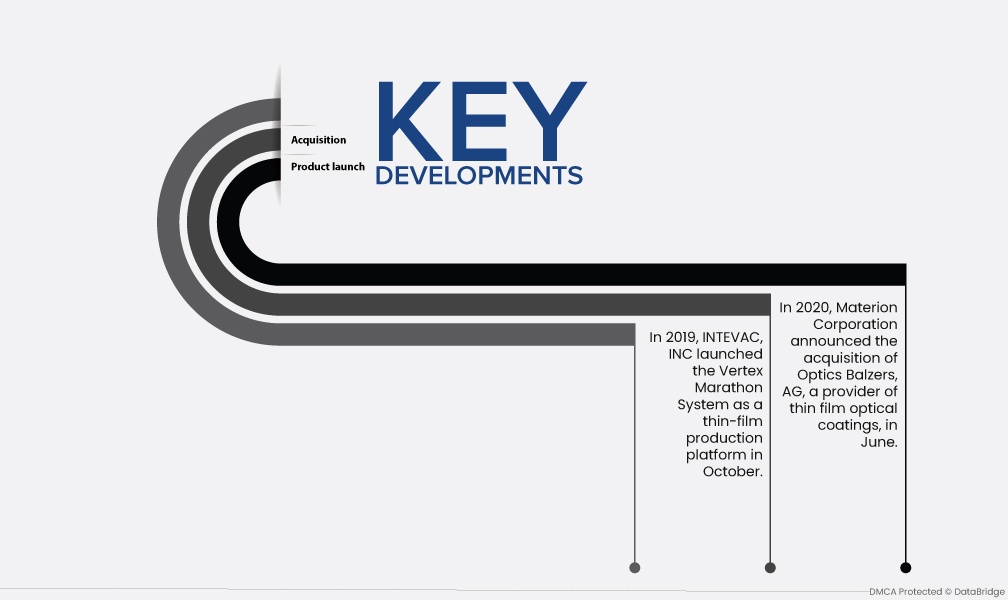Las películas delgadas y ultradelgadas son populares gracias a su ligereza, que permite recubrir otros materiales como metal o plástico. Estas películas se utilizan ampliamente en diversas aplicaciones, como la energía fotovoltaica (FV), la protección contra la corrosión, las baterías, las pilas de combustible, las pinturas y los recubrimientos. Los materiales de película delgada también se utilizan en células fotovoltaicas (FV), que convierten la radiación ultravioleta en electricidad. La célula fotovoltaica funciona como un semiconductor ligero. Además, estas células fotovoltaicas pueden utilizarse para laminar ventanas, lo que permite sustituir las ventanas de vidrio convencionales y reducir los costes de producción.
Acceda al informe completo en https://www.databridgemarketresearch.com/reports/global-thin-and-ultra-thin-films-market
El mercado global de películas delgadas y ultradelgadas se valoró en 5.313,17 millones de dólares en 2021 y se espera que alcance los 22.812,53 millones de dólares para 2029, registrando una tasa de crecimiento anual compuesta (TCAC) del 15,40 % durante el período de pronóstico 2022-2029. El aumento en el uso de energías renovables ha impulsado un incremento en el uso global de paneles solares. Se colocan láminas delgadas de semiconductores sobre metal, plástico o vidrio para formar paneles solares. Estas películas son 20 veces más delgadas que el silicio cristalino, lo que reduce su peso y aumenta la flexibilidad del panel solar. Las películas delgadas y ultradelgadas se dividen en dos tipos: delgadas y ultradelgadas.
Se espera que la creciente demanda de la industria de energía solar y renovable impulse la tasa de crecimiento del mercado.
El uso de materiales de película delgada en las industrias de energía solar y renovable es un importante impulsor del mercado. Estos materiales mejorados proporcionan un excelente recubrimiento, lo que garantiza la fiabilidad de las películas delgadas. Debido a estos factores, se prevé que la demanda global de películas delgadas aumente durante el período de pronóstico. El mercado mundial de materiales de película delgada está en expansión debido a las tendencias en desarrollo de los MEMS y sus aplicaciones en microcomponentes. Los materiales de película delgada también se utilizan en células fotovoltaicas (FV), que convierten la radiación ultravioleta en electricidad. La célula fotovoltaica funciona como un semiconductor ligero. Además, estas células FV pueden utilizarse para laminar ventanas, lo que puede sustituir a las ventanas de vidrio estándar y reducir los costes de producción.
Alcance del informe y segmentación del mercado
Métrica del informe
|
Detalles
|
Período de pronóstico
|
2022 a 2029
|
Año base
|
2021
|
Años históricos
|
2020 (personalizable para 2014-2019)
|
Unidades cuantitativas
|
Ingresos en millones de USD, volúmenes en unidades, precios en USD
|
Segmentos cubiertos
|
Métodos de recubrimiento (estado gaseoso, estado de solución, estado fundido o semifundido), tipo (fino, ultrafino), técnicas de deposición (deposición física, deposición química), aplicación (electrónica y semiconductores, energías renovables, aplicaciones sanitarias y biomédicas, automoción, aeroespacial y defensa, otros).
|
Países cubiertos
|
EE. UU., Canadá y México en América del Norte, Alemania, Francia, Reino Unido, Países Bajos, Suiza, Bélgica, Rusia, Italia, España, Turquía, Resto de Europa en Europa, China, Japón, India, Corea del Sur, Singapur, Malasia, Australia, Tailandia, Indonesia, Filipinas, Resto de Asia-Pacífico (APAC) en Asia-Pacífico (APAC), Arabia Saudita, Emiratos Árabes Unidos, Sudáfrica, Egipto, Israel, Resto de Medio Oriente y África (MEA) como parte de Medio Oriente y África (MEA), Brasil, Argentina y Resto de Sudamérica como parte de Sudamérica
|
Actores del mercado cubiertos
|
American Elements (EE. UU.), LEW TECHNIQUES LTD (Reino Unido), Denton Vacuum (EE. UU.), KANEKA CORPORATION (Japón), Umicore (Bélgica), Materion Corporation (EE. UU.), AIXTRON (Alemania), Kurt J. Lesker Company (EE. UU.), Vital Materials Co., Limited (China), AJA INTERNATIONAL, Inc. (EE. UU.), Praxair ST Technology, Inc. (EE. UU.), PVD Products, Inc. (EE. UU.), GEOMATEC Co., Ltd. (Japón), INTEVAC, INC. (EE. UU.), Plasma-Therm (Reino Unido), Arrow Thin Films, Inc. (EE. UU.), Super Conductor Materials, Inc. (EE. UU.), Angstrom Engineering Inc. (Canadá), ThinFilms Inc. (EE. UU.), Orange Thin Films (Países Bajos)
|
Puntos de datos cubiertos en el informe
|
Además de los conocimientos sobre escenarios de mercado como el valor de mercado, la tasa de crecimiento, la segmentación, la cobertura geográfica y los principales actores, los informes de mercado seleccionados por Data Bridge Market Research también incluyen un análisis profundo de expertos, producción y capacidad por empresa representadas geográficamente, diseños de red de distribuidores y socios, análisis detallado y actualizado de tendencias de precios y análisis de déficit de la cadena de suministro y la demanda.
|
Análisis de segmentos:
El mercado global de películas delgadas y ultradelgadas está segmentado en cuatro segmentos notables que se basan en los métodos de recubrimiento, el tipo, las técnicas de deposición y la aplicación.
- Según los métodos de recubrimiento, el mercado global de películas delgadas y ultrafinas se segmenta en estado gaseoso, estado de solución y estado fundido o semifundido. En 2021, el segmento de estado gaseoso dominó el mercado global de películas delgadas y ultrafinas con una participación de mercado del 50,85 %. El segmento de métodos de recubrimiento se divide principalmente en estado gaseoso y se espera un mayor crecimiento, ya que este método es compatible con las técnicas de deposición más utilizadas, como PVD y CVD.
- Según el tipo, el mercado global de películas delgadas y ultradelgadas se segmenta en delgado y ultradelgado. En 2021, el segmento delgado dominó el mercado global de películas delgadas y ultradelgadas con una participación de mercado del 73,61 %. El tipo delgado ostenta la mayor participación de mercado en este segmento, considerando su amplio uso. Sin embargo, el tipo ultradelgado está creciendo a un ritmo mayor, ya que es el tipo más reciente y está siendo rápidamente adoptado por los fabricantes de paneles solares para sus productos finales.
- Según las técnicas de deposición, el mercado global de películas delgadas y ultrafinas se segmenta en deposición física y deposición química. En 2021, el segmento de deposición física dominó el mercado global de películas delgadas y ultrafinas con una cuota de mercado del 62,83%, considerando su sencilla operación en comparación con las técnicas de deposición química, complejas y menos eficientes.
El segmento de deposición física dominó el segmento de técnicas de deposición del mercado de películas delgadas y ultradelgadas.
El segmento de deposición física se ha consolidado como el segmento dominante en el ámbito de las técnicas de deposición, con una cuota de mercado aproximada del 63 %. Esto se debe al creciente desarrollo de infraestructuras en el mercado, especialmente en las economías en desarrollo. Además, el crecimiento y la expansión de la industria de semiconductores a nivel mundial impulsarán aún más el crecimiento de este segmento.
- En cuanto a su aplicación, el mercado global de películas delgadas y ultrafinas se segmenta en electrónica y semiconductores, energías renovables, aplicaciones biomédicas y sanitarias, automoción, aeroespacial y defensa, entre otros. En 2021, el segmento de electrónica y semiconductores dominó el mercado global de películas delgadas y ultrafinas con una cuota de mercado del 34,89 %. La electrónica y los semiconductores dominan el segmento de aplicaciones, ya que las películas delgadas se utilizan ampliamente para envolver y recubrir materiales semiconductores. Sin embargo, las energías renovables están creciendo a un ritmo mayor debido al rápido crecimiento del sector solar y al uso esencial de películas delgadas y ultrafinas en los paneles solares.
El segmento de electrónica y semiconductores dominó el segmento de aplicación del mercado de películas delgadas y ultradelgadas.
El segmento de electrónica y semiconductores se ha consolidado como el segmento de aplicación dominante. Esto se debe al creciente número de motores eléctricos en el mercado, especialmente en las economías en desarrollo. Además, el crecimiento y la expansión de los servicios de investigación y desarrollo a escala global impulsarán aún más el crecimiento de este segmento.
Actores principales
Data Bridge Market Research reconoce a las siguientes empresas como los principales actores del mercado: American Elements (EE. UU.), LEW TECHNIQUES LTD (Reino Unido), Denton Vacuum (EE. UU.), KANEKA CORPORATION (Japón), Umicore (Bélgica), Materion Corporation (EE. UU.), AIXTRON (Alemania), Kurt J. Lesker Company (EE. UU.), Vital Materials Co., Limited (China), AJA INTERNATIONAL, Inc. (EE. UU.), Praxair ST Technology, Inc. (EE. UU.), PVD Products, Inc. (EE. UU.), GEOMATEC Co., Ltd. (Japón), INTEVAC, INC. (EE. UU.), Plasma-Therm (Reino Unido), Arrow Thin Films, Inc. (EE. UU.), Super Conductor Materials, Inc. (EE. UU.), Angstrom Engineering Inc. (Canadá), ThinFilms Inc. (EE. UU.), Orange Thin Films (Países Bajos).
Desarrollo del mercado
- En junio de 2020, Materion Corporation anunció la adquisición de Optics Balzers, AG, proveedor de recubrimientos ópticos de película fina. Esta adquisición estratégica ampliará la gama de recubrimientos ópticos de película fina de la compañía y su alcance geográfico en Europa y Asia. Gracias a esta adquisición, la compañía ha logrado una mayor combinación de mercados y una cartera de clientes más amplia.
- En octubre de 2019, INTEVAC, INC. lanzó el sistema Vertex Marathon como plataforma de producción de película delgada. Esta innovadora técnica sentó las bases para la producción de película delgada en el mercado de vidrios de cubierta para pantallas. Además, la compañía anunció la introducción del recubrimiento protector DiamondClad. Este nuevo sistema ha ampliado la línea de productos de la compañía.
Análisis regional
Geográficamente, los países cubiertos en el informe de mercado son EE. UU., Canadá y México en América del Norte, Alemania, Francia, Reino Unido, Países Bajos, Suiza, Bélgica, Rusia, Italia, España, Turquía, Resto de Europa en Europa, China, Japón, India, Corea del Sur, Singapur, Malasia, Australia, Tailandia, Indonesia, Filipinas, Resto de Asia-Pacífico (APAC) en Asia-Pacífico (APAC), Arabia Saudita, Emiratos Árabes Unidos, Sudáfrica, Egipto, Israel, Resto de Medio Oriente y África (MEA) como parte de Medio Oriente y África (MEA), Brasil, Argentina y Resto de América del Sur como parte de América del Sur.
Según el análisis de investigación de mercado de Data Bridge:
Asia-Pacífico es la región dominante en el mercado de películas delgadas y ultradelgadas durante el período de pronóstico de 2022 a 2029.
Dada la creciente aceptación de la tecnología en la región, Asia-Pacífico (APAC) domina la industria de películas delgadas y ultradelgadas. En términos de capacidad de fabricación y operaciones de importación y exportación, los mercados de India, China, Corea del Sur y Japón se encuentran en expansión. La base de consumidores de China está creciendo, y una economía en expansión como la de India ha incrementado su capacidad para gestionar mercancías.
Se estima que América del Norte será la región de más rápido crecimiento en el mercado de películas delgadas y ultradelgadas en el período de pronóstico 2022-2029.
Se prevé un crecimiento significativo en América del Norte entre 2022 y 2029 como resultado de la adopción de tecnología y la creciente presión para minimizar las emisiones de carbono en la región. El aumento de la I+D, las actividades de construcción y la demanda de automóviles y electrodomésticos ha beneficiado a la industria norteamericana de materiales de película delgada.
Para obtener información más detallada sobre el informe de mercado de películas delgadas y ultradelgadas , haga clic aquí: https://www.databridgemarketresearch.com/reports/global-thin-and-ultra-thin-films-market












